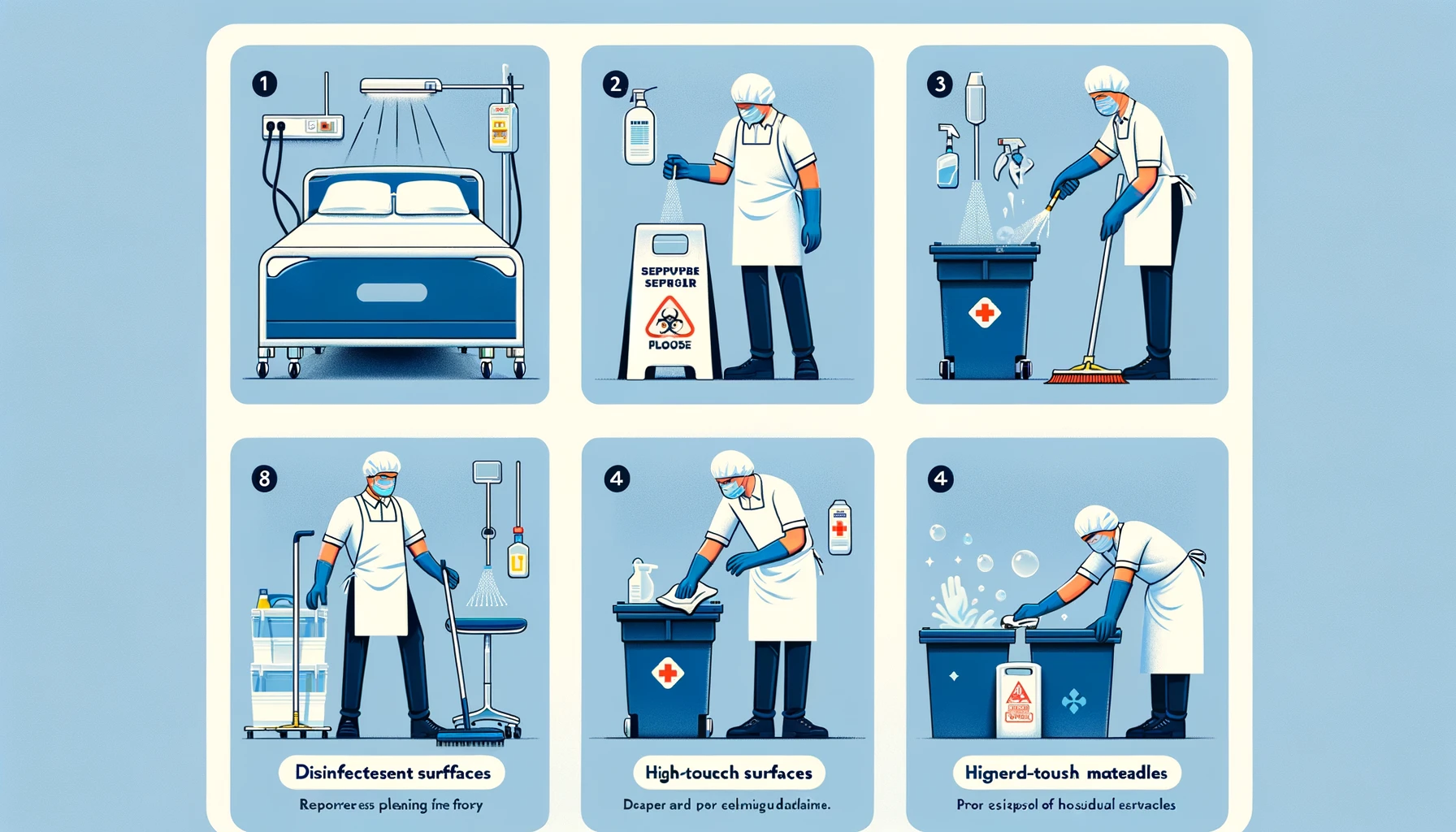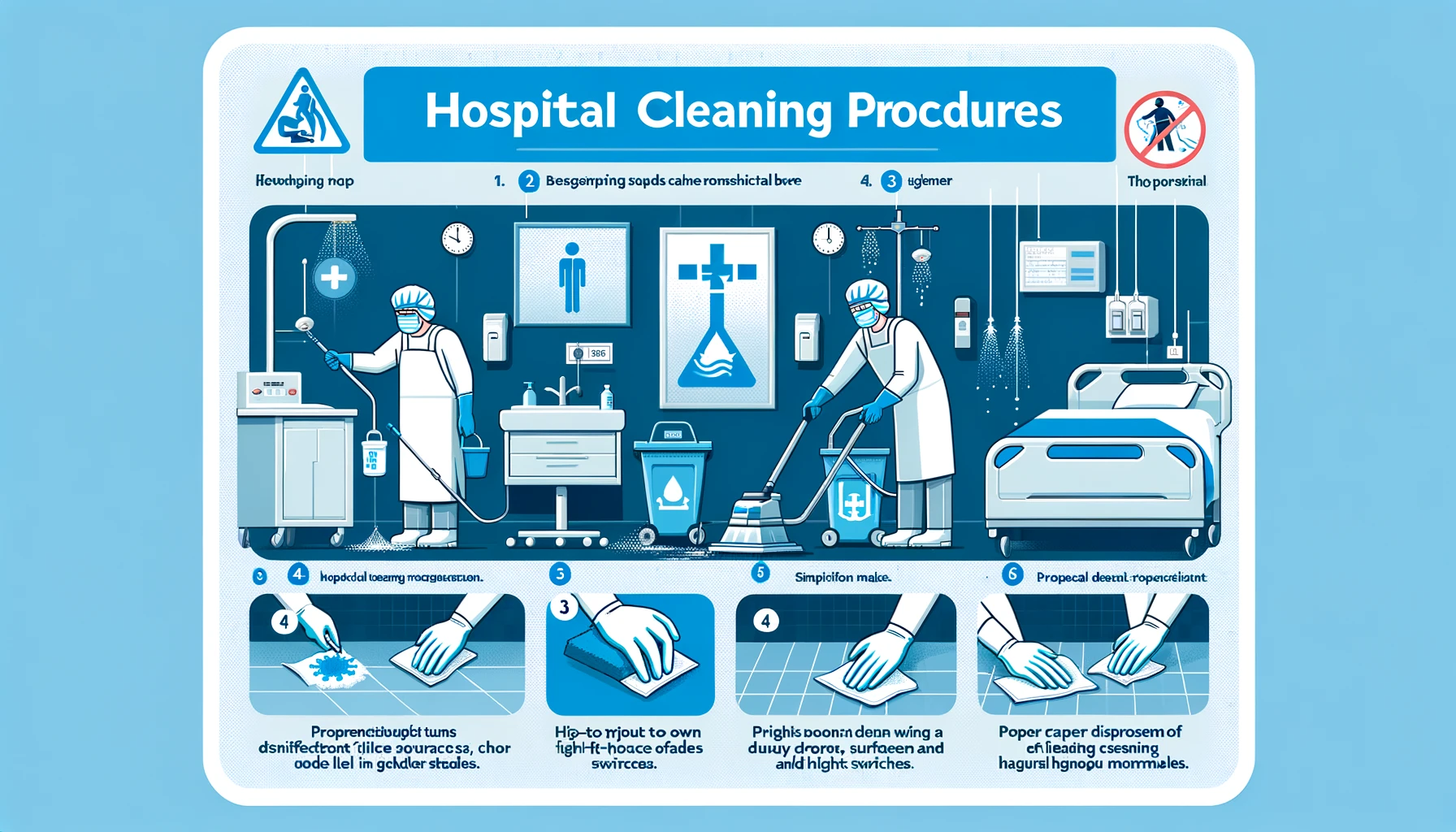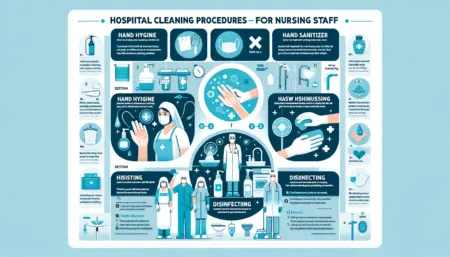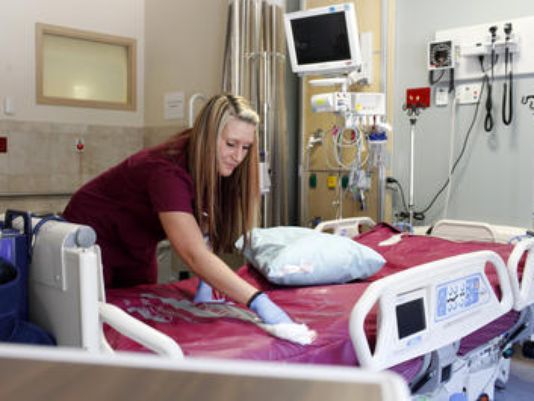Hospital Cleaning Procedures And Methods are very important for every hospital staff.The hospital is a place of several pathogenic organisms. Dust is a source of contamination as it contains various organisms. Therefore clearing of dust from hospital is essential. But this type of cleaning of contaminated sources should never be done by nursing Simultaneously it is the duty of the nursing staff to ensure dost and other such items are cleaned properly. Though the or other domestic staffs are employed in hospital for this cleaning purpose, it is the duty of the nursing staff to supervise these staffs according to their own requirements and priority.

Dangers of Dusts
Dost is a potent source of disease specially in hospital. Hospital contains sand particles coming inside by foot-wear or blown in wind, scales from skin, dried infected matter like pus and other debris of wound, dried threat and nasal secretions, particles of dried threat and nasal secretions. and food particles etc. As such various types of organism and specially virulent types remain in dust. Therefore, dust can Hmp£ disease either by direct contact with wound, eyes, nose, throat or by’ inhalation to lungs or it can contaminate food or water. So proper cleaning of dust becomes a major part of nursing care.

Rules for Cleaning are
- Dry dusting is never advisable. It spreads disease easily.
- Dusting should be done after sweeping only.
- Use a damp duster for collecting dust.
- Dost with clean duster.
- Collect dust at one place to avoid flying from place to place.
- 9 Dusting should be done without disturbing or removing the parents on bed.
- Dusting should be done from top to bottom i.e. from upward Id downward direction.
- While dusting, take care not to spoil the beds or walls other fixers in room or hospital ward.
- While dusting, wounds or dressing should not be opened other staff.
- There should be a definite time for dusting daily.
Hospital Cleaning Procedures And Methods Where You Must Know Hospital Patient Room Cleaning Methods.

Floor :
The floor of hospital wards or nursing homes sho be of polished marble or chipped marble. The floor should not fe covered by matting or carpets which can harbor organisms safely.
- The stains from floor can be removed by a damp cloth, soap or special stone for stain removal.
- The patient or attendants should be taught to wipe out an? such items which are spilled on floor-may be edibles or vomits or drugs etc.
- The floors should be washed with bucket of water. Then it should be swabbed dry.
- After drying one swab soaked with disinfectant fluid be used to wipe the floor.
- At certain places now a-days vacuum cleaners are used to clean floor. But disinfectant swab or wiping is also essential after vacuum cleaning.
Window Doors
- All doors and windows should be washed with soap water properly. Then it should be rinsed with plain water and swab dry.
- Glass pan should also be cleaned by soap and rinsed with plain water.
- Soda and other detergent powders should be used for wooden surface as it may spoil the polish of wood.
Sinks
- Sinks should be cleaned daily in definite interval to avoid contamination and blockage in drainage channels.
- Detergent powders can be sprinkled on sink and rubbed vigorously with damp cloth and then rinsed with plain water and dried with dry cloth.
- Mud or ashes should never be used to clean sinks.
- Stains etc. can be removed by mild acids or stain removers.
- There are several rubber appliances used by patient and nursing staff in hospital. There are catheters, rectal tubes. Ryle’s tube, stomach wash tube,boilable IV transfusion tubes Mackintoshes, hot water bag, ice bag, air cushions, enamel ?ire and gloves etc.
- The cleaning of individual items are done as follows I.V.tubes, Catheters, rectal tubes, Ryle tube, stomach wash tube.
- They should never be kept tied by knots.
- They should be cleaned by running water after use through the eyes of the tubes to ensure that they are not blocked.
- Then they should be cleaned with soap water and rinsed with plain water.
- Rectal tubes are boiled for 5-10 minutes and dried.
- Ryle’s tube, catheter and I.V. transfusion tubes are boiled for 25-30 minutes or autoclave.
MACKINTOSHES
- It can be spread on a table or flat surface then it should be washed with soap water on either surface. Then rinse it with plain water.
- Then it should be dried in shady place not in sun.
- Mackintoshes should never be folded for drying or hanged a hook.
- When dried, dusting powder should be sprinkled before storing.
Hot Water bottles, ice bags, air cushions
- Clean it with soap water and rinse properly.
- Never use boiling hot water.
- Hang bags upside down to drain water.
- Fill some air to keep separate the opposing inner walls. Place stopper before storing.
- If the items have been contaminated in infectious wards, dip it in carbolic acid 1 : 40 sol. for four hours before cleaning with soap water.
Gloves
- It should be washed with soap water and then with cold plain water, both outer and inner sides. The gloves should be checked for any holes or tears.
- When dried, dusting powder should be sprinkled before storing.
- It should be washed with soap water and then with cold plain water, both outer and inner sides. The gloves should be checked for any holes or tears.
- For ordinary ward use, they can be wrapped in cloth and boiled for five minutes.
- For surgical use, they should be dried in shade, powdered and packed in glove wrapper.
- Then it should be autoclave.
- Gloves should never be cleaned with any antiseptic or disinfecting fluid.
Enamel Wares
- Enameled items should not be scraped by any sharp or rough object as the enamel coating is easily chipped off leaving an ugly surface
- It can be cleaned with detergent powder and washed with soap water or plain water and dried.
- If aseptic enamel items like kidney trays or small bowls are required for any surgical or sterile use, small bowls or kidney trays can be boiled in big bowls for 20-30 minutes.
- Alternately phenol or lysol treatment by dipping it for about 4 hours also makes it sterilized.
Bed Pans and Urinals
Bed Pans and urinals are usually cleaned by sweepers or domestic staffs. But nursing supervision and knowledge is essential.
- They should be flushed with cold water after use and brushed properly.
- It should be educated to patients and attendants not to throw cotton sponges or sanitary pads in bed pan or urinals. It blocks and interferes in cleaning properly.
- For disinfection of bed pans and urinals, Lysol 1 : 40 for one hour or phenol 1 : 40 for 4 hours can be applied.
- Sometimes bed pans and urinals are put in direct sunlight for few hours as a common procedure for disinfection.
- Urinals should not be left standing for hours together as it forms a deposit inside, which poses the problem for removal.
- Now a days automatic bed pan washers are being used to disinfect it. Then it is put in boiling water for 5 minutes for sterilization.
Ward Kitchen
Usually the meals to the patients are served by kitchen staff under supervision of nursing staff. Though the cleanliness or maintenance of the central kitchen is not the duty of the nursing staff, still super
Procedure of Cleaning ‘
Visions and cleanliness of the ward kitchen forms a part of duty of nursing staff. The ward kitchen is a place where food stuffs are collected from central kitchen and distributed to the patient by ward attendants.
The cleanliness of ward kitchen should be done as the general patient’s ward is cleaned.
- The ward kitchen should be fly proofed in doors and windows.
- The crockery and cutlery used should be cleaned and rewashed.
- Meal trays should be cleaned, washed and dried after use.
- Uncleaned trays are source of cross infection.
- Any spilled food or milk should be cleaned immediately.
- The food handlers should be checked for cleanliness.
- The nursing staff or staff in charge should report to senior officers if a food handler is found uncleaned or found having any contagious disease.
- No pets should be allowed in ward kitchen.
- The ward kitchen should be ventilated and lighted properly.
Care of Refrigerator
- Refrigerator should be put on D for defrosting.
- The edible items should be removed before cleaning the refrigerator.
- The shelves should be removed for better inspection and cleaning.
- The inside should be cleaned with warm water mixed with detergent powder.
- The food chamber should be cleaned.
- Ice trays should be removed and ice chamber be cleaned.
- The chiller and pan should be removed and cleaned with plain* soap water.
- The ice chamber and inside of Refrigerator should be wiped dry.
- Place the ice trays, chiller and trays.
- Replace the food items removed.
- Ice trays should be refilled with water.
- The outside of refrigerator should be cleaned with light soap water and wiped dry.
- Never use any car polish over painted surface.
- Never keep any hot food inside.
- Never keep the refrigerator inside knob in “maximum position” routinely.
- The door of refrigerator should not be opened too frequently. Never keep old expired drugs or serum or spoiled food or vegetables.
- If not required for use for long, clean and dry and disconnect electric switch.
